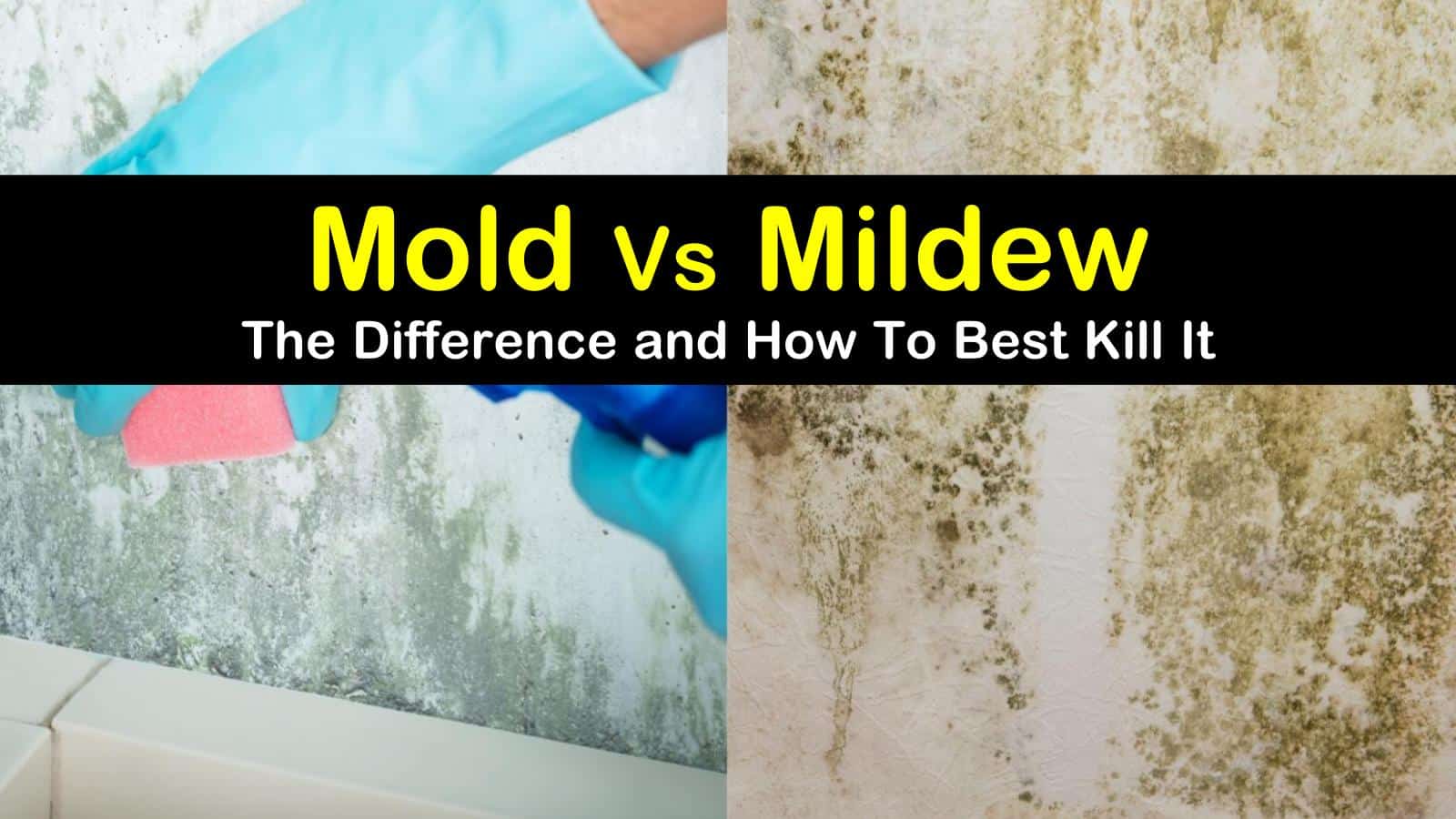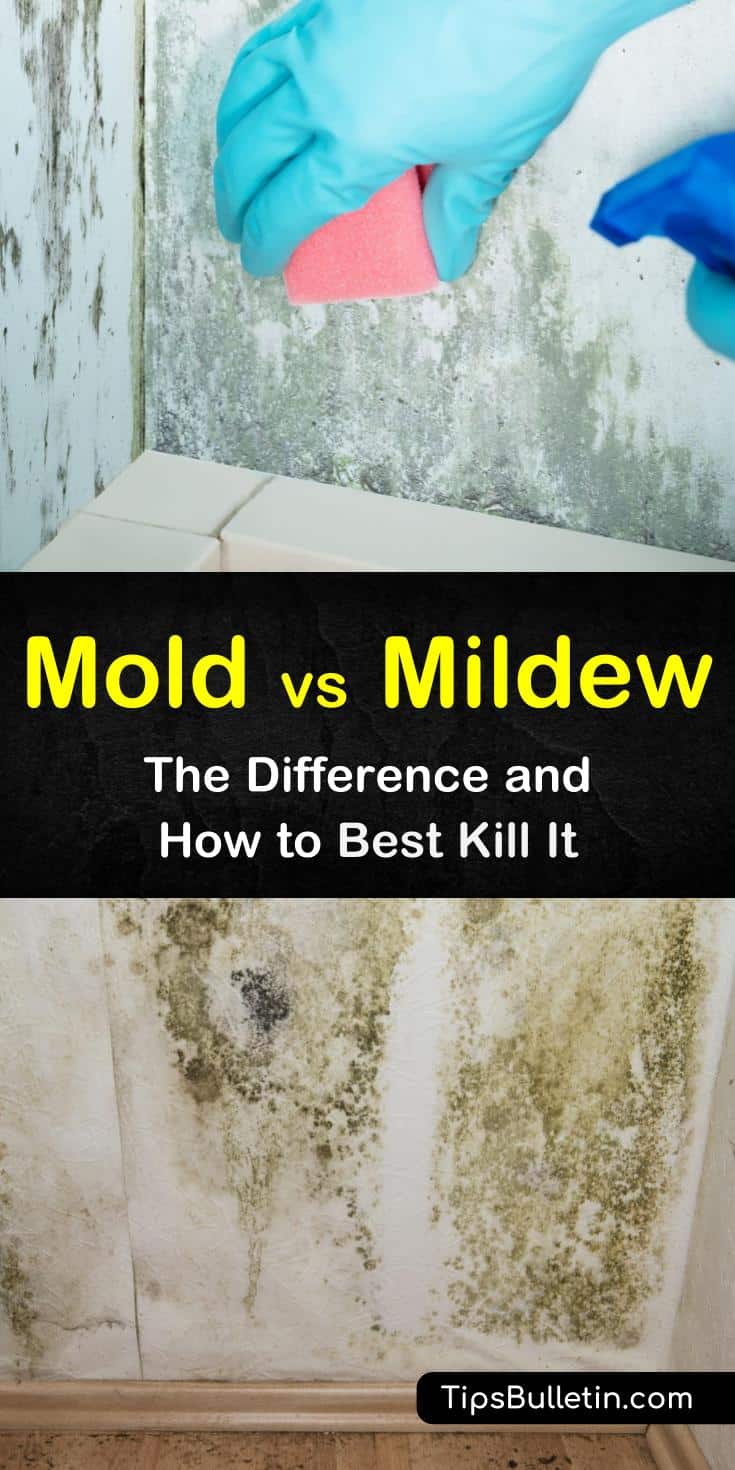It’s happened to all of us: we step into the shower or walk into a little-used area of our home and find unsightly patches on our walls, ceiling, or floor. It’s all too easy to wind up with stains on damp surfaces in our house, and knowing the difference between mold and mildew can help us identify the issue and how to fix it.
To clean our home effectively, we need to be aware of how to tell mold vs mildew and what we can do to get rid of both of them. In this guide, we take a close-up look at mildew and mold.
We show you how to identify them and where in your house you might encounter them, and we also give you a rundown of the effects that they can have on your family’s health. And, we give you recipes for a tried and true DIY mold and mildew remover so your family stays healthy and happy.

Mold and Mildew – How are mold and mildew different?
Mold and mildew are both fungal infestations that look for friendly environments in which to take root and grow. To make sure that you are tackling the right types of fungi, you need to be able to tell the difference between the two.
Being able to recognize mold vs mildew at first glance will allow you to apply the correct solution and can mean the difference between hours of scrubbing and easy cleanup.
Mildew
In this section, we’ll get to know mildew in all its forms. We tell you how to recognize mildew by sight and smell and show you where you’re most likely to encounter mildew in your home.
We also give you a method to get rid of mildew that you can also use to clean mildew from leather. By the time we’re through, you’ll know mildew forward and back.
What is mildew and where can you find it?
Let’s start with the mildew definition. Like mold, mildew originates as spores floating in the air. They love warm and damp areas and can take root in any moist area in your home.

Mildew spores and mold spores part ways when it comes to appearance, though. Mildew usually comes in grey, yellow, or white.
Downy mildew has a fluffy texture and powdery mildew crumbles into white dust at the touch. You’re likely wondering, “What does mildew smell like?” Well, it varies, but mildew generally produces a stale, faintly musty smell.
You’ll find mildew all over the house, especially in dark and hard-to-reach corners. If you have standing water or leave a surface damp for too long, there’s a good chance you’ll discover mildew and a musty odor at some point. Mildew loves crawl spaces and other stuffy little areas with high humidity, and you’re sure to encounter it in your bathroom from time to time.
Mildew Health Impact and Cleaning
While having mildew in your home isn’t as dangerous as living with mold, it can still have health effects on you and your family. Mildew causes respiratory issues, especially in the elderly and young children. Mold can cause even more serious health concerns.
Being around mold and mildew can also lead to infections and could snowball into more significant problems. Studies have linked mildew to chronic pain, headaches, muscle aches, fatigue, and skin rashes.
In the battle of mold vs mildew, mildew is the easier foe and takes much less effort to eliminate. Getting rid of mold can be challenging, as mold digs in deep to your walls and grout. Mildew usually sticks to the surface and can be cleaned away without too much difficulty. We’ve included a fantastic natural mildew remover recipe so you can tackle your mildew stains without trouble.
Fill the bottle with vinegar and spray it on the mildew growth, whether it is on a floor, you need a way to get mold off carpet or from inside the washing machine. Allow the vinegar to sit for about five minutes, then scrub at the stain with the brush.
Repeat until the stain is gone. Soak the sponge in water, wring it out, and wipe away the vinegar. Finally, dry the area by blotting with the cloth.
Mold
Because mold can be much more dangerous to your family’s well-being than mildew and can result in health issues, it’s even more important to be able to pick it out of a lineup and know what to do when you run across it.
To be fully prepared for any eventuality, you need to know what you’re looking for and how to handle it.
Recognizing the signs of a mold infestation will help you to catch the problem when it’s still new so you can nip it in the bud. This section will acquaint you with mold growth in all its forms.
We let you know what mold looks, feels, and smells like, and we let you know about the health impacts mold can have when it’s allowed to grow unchecked. We also share our favorite mold remover recipe, which you can use for cleaning plastic outdoor furniture and your interior and garage.
What is mold, and where can you find it?
Mold begins life in much the same way as mildew, as a single fungal spore looking for moist environments around organic materials. When it finds a dark spot with high humidity levels and enough heat, it makes a home there and gets to work.
Mold comes in all textures and colors, but is usually much thicker than mildew and can even become furry and plant-like if left alone for long. Depending on the type of fungus and moisture level, mold can present a sickly, slimy appearance, too.
Mold comes in all shades, but the most common is green, black, or yellow. Mold smells much stronger than mildew and has a unique stale, wet odor.
You’ll find mold in many of the same spots that mildew enjoys. Any crawl space, basement, garage, bathroom, or attic is fair game as long as they offer the kind of environment that mold prefers. Basements, with their direct contact with damp earth, are especially susceptible to deep mold infestations.
If you find mold in your car, remove mold from the car interior quickly before it spreads. The closed environment of the car makes it dangerous for mold to sit and it exposes passengers to harmful spores.
If you discover mold on your wood or composite deck, remove green mold from a wood deck with a pressure washer and a cleaning solution that includes vinegar or Borax for best results.
Mold Health Impact and Cleaning
Some types of mold cause severe health problems if allowed to grow unimpeded. Black molds are the most hazardous types of mold and can affect your indoor air quality, as well as your health.
How to clean black mold is a little different than cleaning other types of mold but safety precautions must be taken when treating all kinds of mold problems. Many molds, including common mold, can cause all sorts of health risks, especially for individuals with compromised immune systems like the elderly and infants.
The effects of mold are insidious and include nasal trouble, sore throat, asthma, and allergic reactions. Respiratory problems often get their start from mold exposure, as well, so removing mold should always be a priority, especially if a family member is having difficulty breathing.
It’s incredibly important to clean mold as quickly as possible because it can also cause structural damage if allowed to grow. Mold removal can be a tricky proposition.
If you catch your mold infestation early enough, you can often wipe it away with only a little effort. However, because toxic mold can dig deep into your plaster walls and ceilings, you may need to call professionals for mold remediation if the infestation gets out of control.
Prevent that from happening by attacking your mold problem with this excellent cleaning product that uses hydrogen peroxide, an antifungal agent, and one of the better natural household cleaners you’ll find.
Fill the bottle with hydrogen peroxide, and spray the mold patch until it’s completely wet. Let the peroxide work on the mold for at least fifteen minutes, and scrub the spot with the brush, wetting it as needed to remove mold. When the mold has been scrubbed off, soak the sponge in water, and rinse the area.
Dry the spot with your cloth; this is especially important when working on plaster to prevent water damage. Prevent mold by spraying peroxide on your tiles after your shower, too.
Mold vs Mildew
We hope you enjoyed this guide to mold vs mildew. It’s easy to let in some spores and wind up with an unsightly patch on your tile or walls.
That’s why it’s crucial to know the difference between mold and mildew so you can identify the culprit and attack it with a powerful DIY mold and mildew remover. Our guide gives you the information you need to keep your home clean and fungus-free.

Thank you for reading our mold vs mildew guide. If you found the information on how to tell the difference between mold and mildew helpful, please share our DIY home mold and mildew cleaner tips on Pinterest and Facebook.